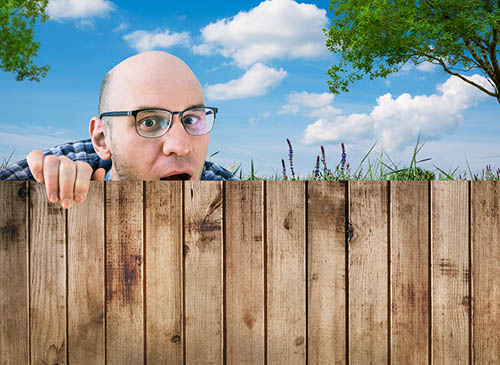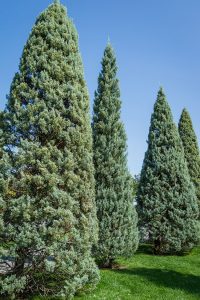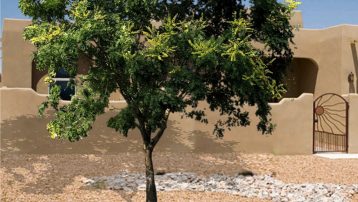Last updated on January 20th, 2024 at 07:05 am
Here is a question I get all the time “How to block neighbors’ view of my yard”? You could build an expensive brick, wood, or steel wall to do this. Furthermore, your best option is to use large evergreen trees or plants,
However, what you need are privacy plants, folks want something that will block the neighbors from looking into your yard. Often, they want to block the view of the neighbor’s yard. Either way, some plants and trees will help you do this.
Privacy Plants

Some numerous large shrubs and trees will help you block your neighbor’s view. Naturally, Most garden nursery stores will have these plants, but they are typically small to medium-sized plants. If you are looking for super large almost full-grown plants, you might have to call your local landscapers. Heavy equipment is needed to move large trees.
Call 811 first
Obviously, It is important to call 811 before digging large holes in your area. What is the 811 one call center? It is a free service to inform underground utilities or pipeline owners of any called-in excavation activities that could potentially affect their underground facilities. Here is a link to further information. Call 811.
Privacy Plants
Blue Point Junipers will (Juniperus Chinensis)
They are good-looking fast-growing evergreen conifers. They will grow about 12-14 ft. tall and about 8-10 in width. These conifers do provide cover at about the tenth year of growth. Also, Spider mites love junipers so that is something to keep your eye on. Here is a post about spider mites and other insects that will damage or kill junipers and other plants. Insects and diseases on plants.
USDA Zone 4- 9.
The Wichita Blue Juniper is another good Juniper…smaller but has a nice color and is drought tolerant.
Wichita Blue Juniper.
Spartan Junipers (Juniperus Chinensis)
These are fast-growing formal-type conifers. The best thing about these plants is that they require little to no maintenance. They will shoot up and grow to 15 ft. tall and about 6 ft in width. The ones pictured below are pruned to give them that formal look. Don’t prune them and they will get wider for more background coverage. Plant them in full sun but they can tolerate about 3-4 hours of shade you can have them in the shade they need at least 6 hrs. of sun.
USDA Zones 4 – 9

Afghan Pine Trees
Also called Pinus Eldarica pine, Mondell pine, and Desert pine. These conifers will do the job and they will do it quickly. A fast-growing pine tree is suitable for the southwest. Very drought-tolerant pine trees once they become established. They will grow best in full sun but can take a lot of shade.
The one big problem with these pine trees is their constant dropping of pine needles and pinecones. There is a lot of maintenance involved year after year. The growth rate is fast, and they will grow up to 70 ft. tall and about 10 ft. in width. Even larger after 30 years or so. Well suited for Xeriscaping Yard.


Dwarf Golden Arborvitae (Thuja occidentalis)
An excellent privacy tree is the dwarf golden arborvitae, which is a conifer and a good evergreen tree that will provide a good border wall screen. The name is a little misleading as this tree will reach 8 ft. tall sometimes larger within time. The Dwarf Golden Arborvitae loves the southwest weather and does grow quickly. Golden yellow foliage during spring will turn a bronze color during the winter seasons. Moderate watering once it gets established. Will grow up to 10 ft. tall or more and about 5 ft. wide. Zones 6 – 9. Like most conifers, they are susceptible to spider mites. Especially in areas where there are dry conditions and little rainfall.
USDA Zone 4 – 8

Wax leaf Privet (Ligustrum japonicum)
These plants have glossy evergreen foliage and will produce a nice small white flower in mid-spring. They can take partial or full sun. It can also act as a stand-alone plant or plant several in a row for a nice hedge. It does great in decorative containers and can be used as a topiary plant. USDA Zone 7 – 11

Red Tip Photinia (Photinia x fraseri)
This evergreen plant can grow up to 8 ft. tall and 5 ft. wide. It makes a great screen wall, and the foliage will produce nice reddish/bronze-type leaves towards the top of the plant. It will also produce a white flower in mid-spring. Use it as a stand-alone plant in a container or in the ground.

An excellent plant known for its red tip color in fall and spring. These plants like to be watered consistently in the first 3-4 years of growth. Once established it will require water every other day during the sweltering summer seasons. Grows in USDA zones 7 – 11. Read more about the Red Tip Photinia.
Golden Euonymus (Euonymus japonica)
A great shrub for a border screen. They will grow up to 6-7 ft. in height and about 3-4 ft. in width. Moderate to fast-growing hedge-type shrub. Prune it to fit your needs. Makes a square or round topiary as it loves pruning. It produces a small white flower in early spring. It can be planted in full sun or partial shade. Moderate watering after establishment.
USDA Zones 6-9.
Hollywood Junipers (Juniperus Chinensis)
Hollywood Junipers is an excellent choice when it comes to privacy trees. They grow and twist from one side to the other, giving it a unique character form. It is drought tolerant once it becomes well established, usually after the third year or so.
USDA Zones 5-9

Oleander Plants (Neirum Oleander)
Oleanders are good privacy plants, and they are drought tolerant once they become well established usually after the third year or so. Water occasionally during the sweltering summer months produces more growth and flowering. They thrive in poor soil but will do better if planted in good soil. They are fast growers and can be used as a border wall for privacy or street noise. Oleander flowers come in red, white, pink, and yellow. Learn more at Oleander Plant Care.

Cypress trees will help with blocking the view into your yard. Very little pruning or maintenance is required. They can tolerate poor soil but will do better with well-composted at initial planting. Once they become established, they need little water. Additionally, Cypress trees are used for noise reduction or a border wall for privacy concerns. Cypress Trees block the view.
How to block neighbors’ view of my yard
with Privacy Plants
What is your USDA hardiness zone? Find out here.
Find out about insects and diseases on these plants and trees.









Surprised not to see Arizona Cypress on this list; they grow very fast and are fragrant, too. I tried Leyland Cypress, but after 6 years (and almost 20 feet high), they started to brown rapidly; had to remove them; never figured out what was wrong with them. Italian Cypress also can make a decent, tall hedge. Holly can also provide some evergreen privacy.
Yes, Brian, Arizona Cypress is a good tree for privacy. For more information on all types of Cypress trees visit Cypress trees for the Southwest.
Live Oak also do well out here if you have the space and money. In my experience, they are the fastest growing oak in the El Paso area when cared for properly.
Suggestions for privacy plants that are not poisonous to dogs and goats?
Thanks for your suggestion. We will provide an article on the subject in the near future.